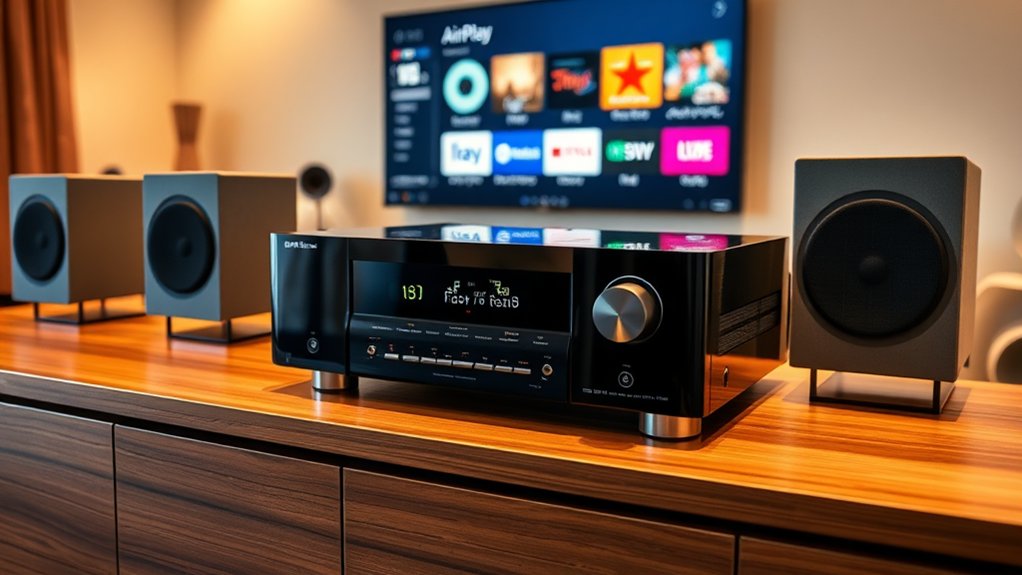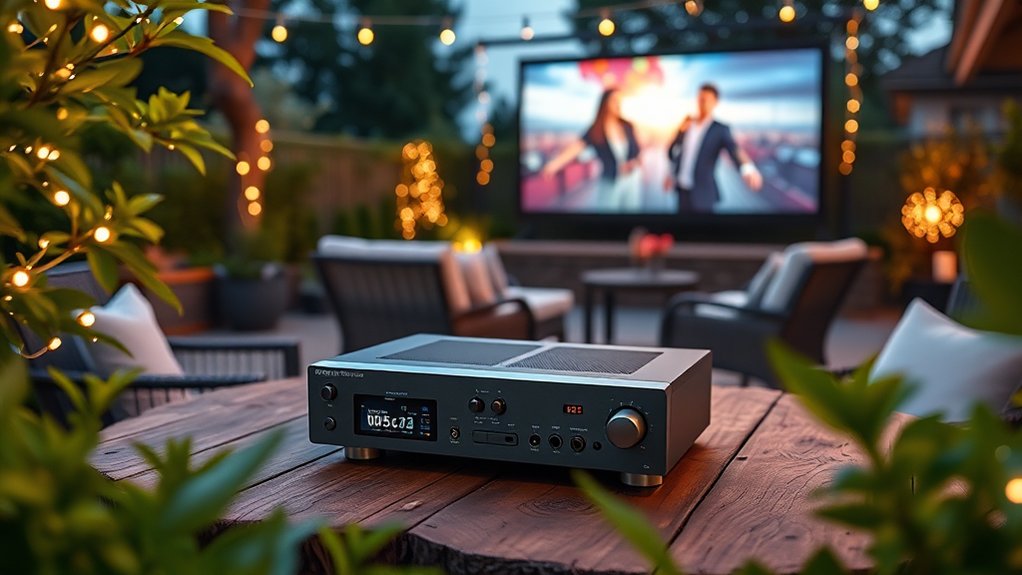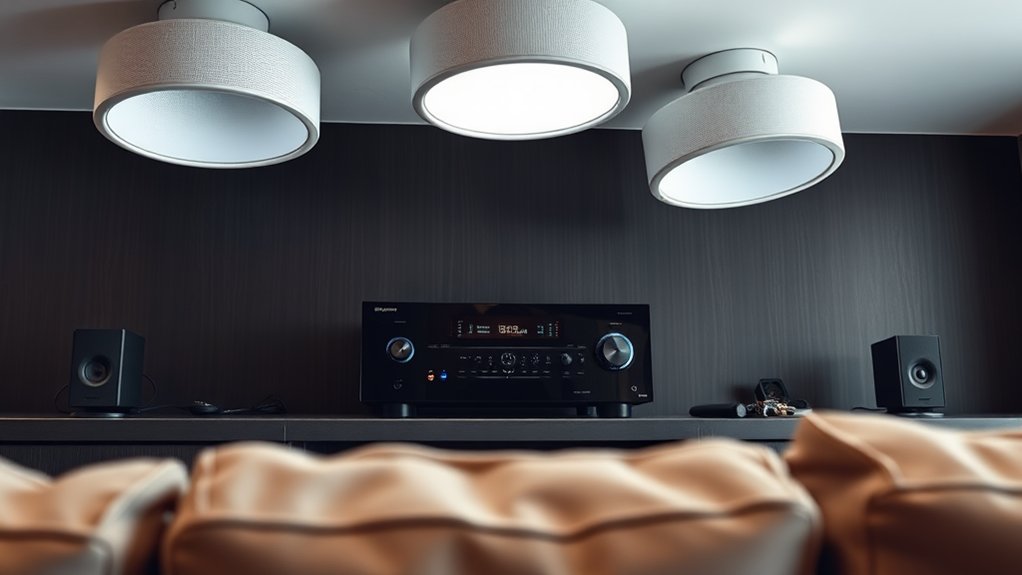If you’re looking for AV receivers that work with Apple AirPlay, you’ll find great options from brands like Yamaha, Denon, and Onkyo. Models such as the Yamaha RX-V6A, Denon AVR-X3800H, and Onkyo TX-NR6100 can easily stream audio and video from your Apple devices. Many support AirPlay 2, enabling multi-room functionality. Plus, who wouldn’t want seamless wireless options instead of tangled cords, right? Stick around, and I’ll fill you in on more features and choices!
Key Highlights
- Leading brands like Yamaha, Denon, Onkyo, and Sony manufacture AV receivers compatible with Apple AirPlay.
- Models such as Yamaha RX-V6A, Denon AVR-X3800H, and Onkyo TX-NR6100 support seamless Apple connectivity.
- AirPlay 2 is supported by various models, enhancing multi-room audio and improved streaming functionality.
- Many AV receivers offer support for major audio formats, including Dolby Atmos and DTSX for optimal sound quality.
- Upgrading older receivers can enable AirPlay 2 capabilities for enhanced wireless streaming performance.
Overview of Apple AirPlay and AirPlay 2 Compatibility
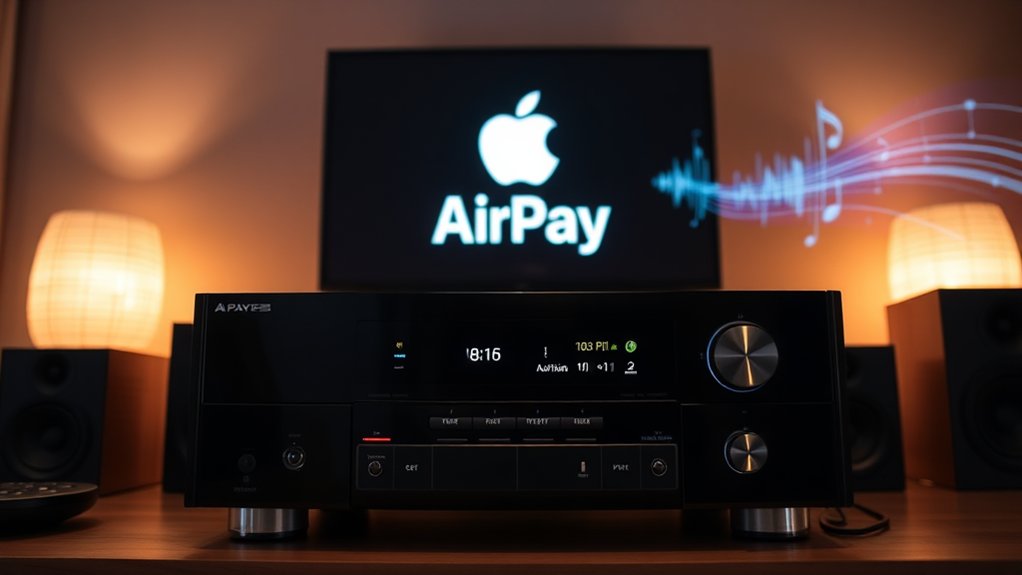
With regard to streaming music and video wirelessly, Apple’s AirPlay and its upgraded version, AirPlay 2, stand out as two of the most user-friendly options available. AirPlay allows you to wirelessly send audio and video from your Apple devices to compatible receivers, which includes everything from speakers to smart TVs. Additionally, many of these devices, including some smart home equipment, support Touch Accommodations that enhance usability for users. But AirPlay 2 takes it up a notch, enabling multi-room audio that syncs across different devices. Imagine not having to play DJ just to hear your favorite tunes throughout the house! Plus, AirPlay 2 supports continued playback during iPhone calls—a handy feature, right? Furthermore, many older AV receivers can be upgraded with separate devices to achieve AirPlay 2 functionality, enhancing their streaming capabilities. With native integration on iOS, iPadOS, and macOS, you won’t need extra hardware.
Leading Brands Offering AirPlay Support
In relation to enjoying your favorite tunes or binge-watching shows, having the right AV receiver can make all the difference. Leading brands like Yamaha, Denon, Onkyo, and Sony offer solid AirPlay support. For instance, Yamaha’s RX-V6A and the RX-A2A in the Aventage series guarantee seamless connection with Apple devices, whereas Denon’s AVR-X3800H delivers high-quality sound with modern connectivity. If you’re looking for affordability, Onkyo’s TX-NR6100 fits the bill, and Sony’s STR-AN1000 balances value and performance well. Many of these receivers even feature multi-room audio support, so your music can follow you as you roam the house—who doesn’t love a soundtrack to their own life? Additionally, supporting major audio formats like Dolby Atmos and DTSX is a common feature across these receivers. With these brands, you’re set for smooth streaming! However, it’s crucial to note that issues with server stability can sometimes interfere with the streaming experience, similar to how users faced challenges during a recent incident on a popular data science platform.
Top AV Receiver Models for 2025
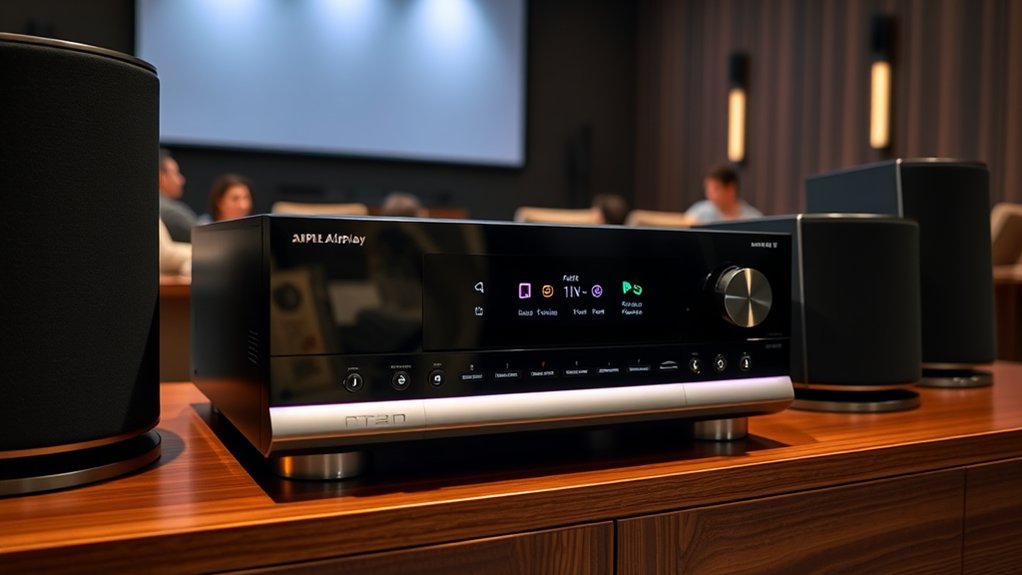
In regard to selecting an AV receiver for 2025, you’ve got a wealth of impressive options that can truly improve your audio-visual experience. If you’re after high-quality sound, the Yamaha RX-A4A shines with its Dolby Atmos support and strong streaming features like AirPlay 2. Additionally, the Denon AVR-X1800H provides robust wireless connectivity with built-in Bluetooth and Wi-Fi, enhancing your streaming capabilities. For a more elite choice, consider the Denon AVR-X4800H, which offers exemplary sound quality and user-friendly setup. Maybe you’re looking for a balance of quality and price? The Pioneer Elite VSX-LX505 is a solid mid-range pick. If you’re all about overall performance, the Sony TA-AN1000 has you covered. And for those craving home audio power, the JBL MA7100HP delivers immersive sound with ease. Are you ready to lift your home theater?
Key Features of AirPlay-Enabled AV Receivers
Selecting an AV receiver isn’t just about fantastic models; it’s important to understand the features that make these devices stand out, especially when you’re looking at AirPlay-enabled receivers.
These receivers support seamless wireless streaming from your iOS and macOS devices, using the AirPlay protocol—no need for messy cables or adapters! You can enjoy high-quality audio with Apple Lossless codec, ensuring your tunes sound fantastic.
Moreover, with AirPlay 2, you can sync audio across multiple rooms and control each with ease. And let’s not forget the handy interface that displays track info right on your screen.
Differences Between Stereo and AV Receivers
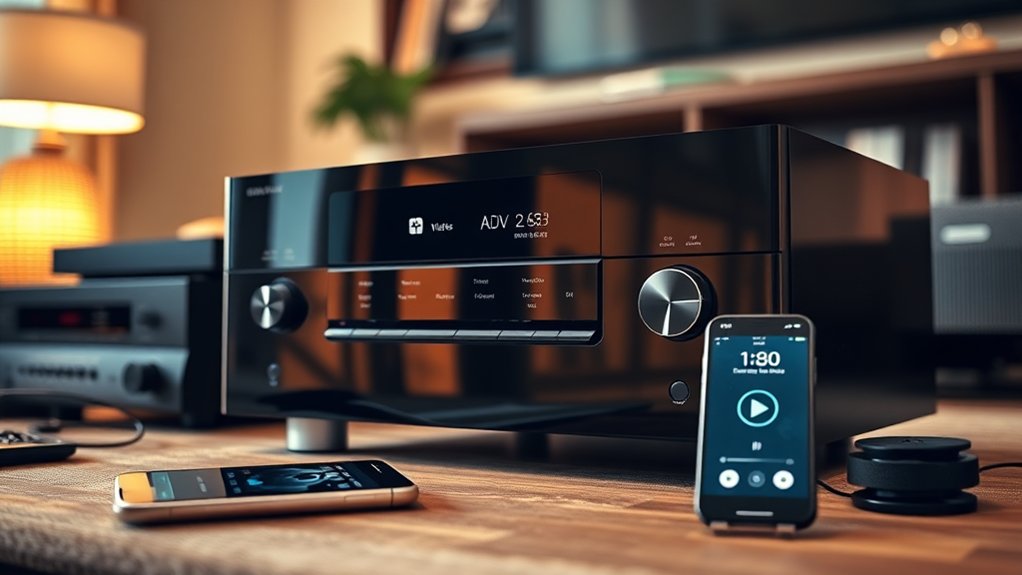
Though you might think all receivers are created equal, there are significant differences between stereo receivers and AV receivers that can greatly impact your audio-visual experience.
For instance, AV receivers process both audio and video signals, serving as hubs for numerous inputs, whereas stereo receivers focus solely on enhancing music playback. Imagine trying to play a video game through a stereo amp—just not going to happen!
AV receivers boast HDMI inputs for modern setups and multi-channel amplification for an immersive movie night, whereas stereo amplifiers excel in audio fidelity, appealing to audiophiles seeking pure music quality.
In the end, if you need versatile home entertainment, go for an AV receiver; if you’re after serious sound for music, a stereo amp might be your best bet.
Limitations of AirPlay on AV Receivers
Though AirPlay can effortlessly improve your streaming experience, relying solely on it for your AV receiver might lead to some frustrations due to its inherent limitations.
For starters, streaming high-resolution audio directly from your iOS devices is a bit of a gamble, often capping out at 16-bit/44.1kHz. That’s great for a casual listen, but audiophiles, you might find it lacking.
Plus, there’s a potential for annoying latency issues, especially if you’re trying to sync audio with video.
And let’s not forget about compatibility; some AV receivers need extra gear to facilitate AirPlay, complicating your setup.
With all this in mind, you might wonder if AirPlay is really the best choice for serious listening experiences.
How to Choose an AirPlay Compatible Receiver
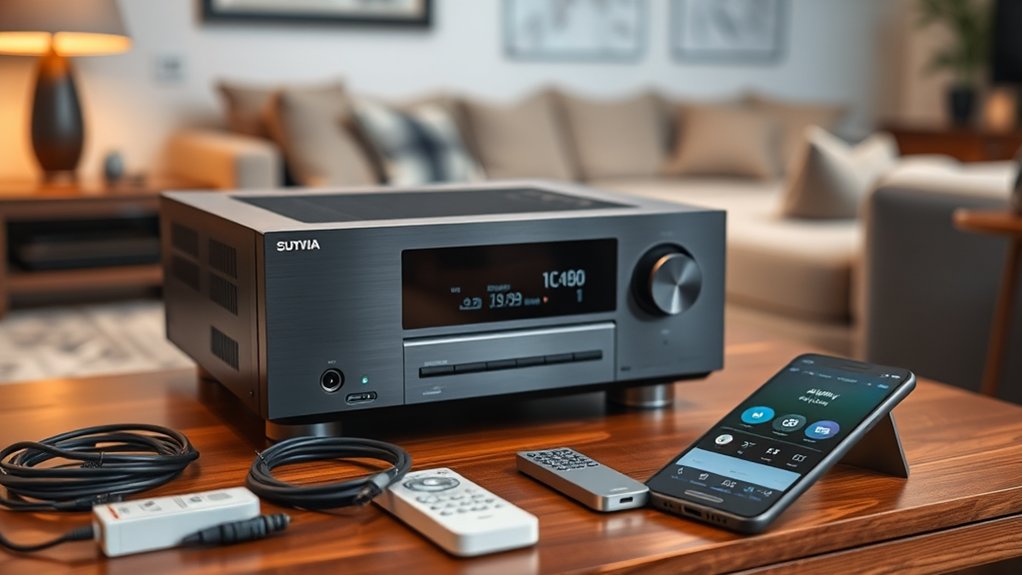
How do you make certain you’re choosing the right AirPlay compatible receiver for your needs?
First, confirm that it explicitly supports AirPlay 2, ideally with a logo or mention in the specs. Integrated Wi-Fi is crucial, ensuring seamless streaming, whereas HDMI connections make setup easier.
Evaluate whether it includes both Wi-Fi and Bluetooth capabilities for versatile use. Don’t overlook sound quality—after all, who wants crummy audio for their favorite tunes?
Furthermore, think about your budget: a Yamaha RX-V6A might suit beginners, whereas serious audiophiles could consider pricier options like the Denon AVR-X3800.
Finally, a user-friendly interface can make controlling your receiver a walk in the park, don’t you think?
Frequently Asked Questions
Can I Use Airplay 2 With Older AV Receiver Models?
You can’t directly use AirPlay 2 with older AV receivers since they lack native support. Nevertheless, using an Apple TV or compatible adapter allows workaround solutions to facilitate streaming capabilities with some limitations.
Do All Airplay-Compatible Receivers Support Multi-Room Audio?
Not all AirPlay-compatible receivers support multi-room audio. To achieve synchronized playback, you need a receiver with AirPlay 2. Otherwise, you’re limited to streaming in a single room with older models or basic AirPlay functionality.
Is Airplay 2 AVailable for Free With My AV Receiver?
You can often find AirPlay 2 available for free through firmware updates on compatible AV receivers. Check your specific model’s documentation to see if it supports this upgrade without needing to purchase new hardware.
Can I Control My Airplay 2 Devices With My Smartphone?
Yes, you can control your AirPlay 2 devices with your smartphone. Simply use the Apple Home app or iOS Control Center to manage playback, volume, and device grouping, making your streaming experience seamless and convenient.
What Audio Formats Does Airplay 2 Support?
AirPlay 2 supports audio streaming in ALAC up to 24-bit/48kHz, primarily maintaining stereo output. It doesn’t handle multichannel formats like Dolby Atmos, nor high-res audio beyond 48kHz, limiting your playback options.

